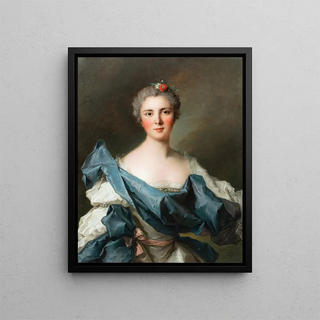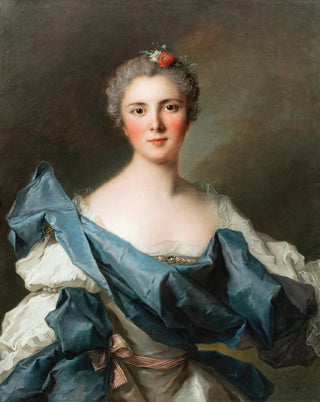Art print | Portrait of Marie Henriette de Polastron, Countess d'Andlau, c. 1716-1792 - Jean-Marc Nattier


View from behind

Frame (optional)
In the fascinating world of 18th-century French painting, the work of Jean-Marc Nattier stands out for its ability to capture the very essence of his subjects. The portrait of Marie Henriette de Polastron, Countess d'Andlau, is a vibrant testament to an era where art and society intertwined harmoniously. This painting, depicting a woman of rare elegance, immerses us in a universe where beauty and refinement are omnipresent. Through this portrait, Nattier does not merely depict a noble lady; he immortalizes a personality, a story, and a lifestyle unique to French aristocracy.
Style and uniqueness of the work
Nattier's style is characterized by a finesse and delicacy that are his signature. In the portrait of Marie Henriette, a subtle use of pastel colors can be observed, lending the canvas a soft and soothing atmosphere. The countess's face, delicately modeled, expresses both grace and dignity, while her clothing, adorned with refined details, reflects the fashion of the time. Every element, from the choice of fabrics to the pose, is carefully considered to highlight the beauty of his subject. The light, playing on the drapes and textures, creates an almost three-dimensional effect, inviting the viewer to approach and contemplate the nuances of this work. This portrait, while a tribute to nobility, also offers a reflection on female identity in the 18th century, where women are both muses and active participants of their era.
The artist and his influence
Jean-Marc Nattier, born in 1685, is one of the most prominent portraitists of his time. Trained at the Royal Academy of Painting and Sculpture, he developed a style that combines classical influences with Rococo elements. His ability to capture the soul of his models earned him quick recognition within aristocratic circles. Nattier became the official painter of many court personalities, including the famous Madame de Pompadour.

Matte finish

View from behind

Frame (optional)
In the fascinating world of 18th-century French painting, the work of Jean-Marc Nattier stands out for its ability to capture the very essence of his subjects. The portrait of Marie Henriette de Polastron, Countess d'Andlau, is a vibrant testament to an era where art and society intertwined harmoniously. This painting, depicting a woman of rare elegance, immerses us in a universe where beauty and refinement are omnipresent. Through this portrait, Nattier does not merely depict a noble lady; he immortalizes a personality, a story, and a lifestyle unique to French aristocracy.
Style and uniqueness of the work
Nattier's style is characterized by a finesse and delicacy that are his signature. In the portrait of Marie Henriette, a subtle use of pastel colors can be observed, lending the canvas a soft and soothing atmosphere. The countess's face, delicately modeled, expresses both grace and dignity, while her clothing, adorned with refined details, reflects the fashion of the time. Every element, from the choice of fabrics to the pose, is carefully considered to highlight the beauty of his subject. The light, playing on the drapes and textures, creates an almost three-dimensional effect, inviting the viewer to approach and contemplate the nuances of this work. This portrait, while a tribute to nobility, also offers a reflection on female identity in the 18th century, where women are both muses and active participants of their era.
The artist and his influence
Jean-Marc Nattier, born in 1685, is one of the most prominent portraitists of his time. Trained at the Royal Academy of Painting and Sculpture, he developed a style that combines classical influences with Rococo elements. His ability to capture the soul of his models earned him quick recognition within aristocratic circles. Nattier became the official painter of many court personalities, including the famous Madame de Pompadour.






